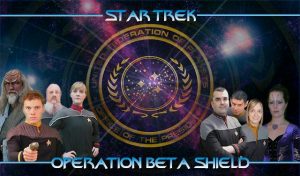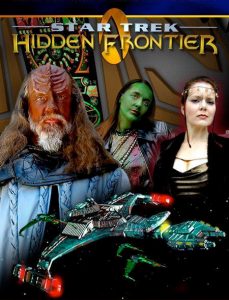 Last week: we looked at the trailblazing fan series Star Trek: Hidden Frontier, one of the harbingers of the “modern age of Star Trek fan films.” From its humble beginnings as just a fun activity for the STARFLEET fan club chapter USS Angeles, Hidden Frontier turned into a fan film production dynamo for more than a decade, going on to produce 50 episodes over seven seasons plus five spin-off series and even cross-overs with other fan series. Hidden Frontier broke new ground in using green-screen compositing, generating home-made 3D visual effects, recasting established characters from Star Trek canon, and even featuring the first gay Starfleet officers in a fan film series (sorry, New Voyages, HF beat you to it).
Last week: we looked at the trailblazing fan series Star Trek: Hidden Frontier, one of the harbingers of the “modern age of Star Trek fan films.” From its humble beginnings as just a fun activity for the STARFLEET fan club chapter USS Angeles, Hidden Frontier turned into a fan film production dynamo for more than a decade, going on to produce 50 episodes over seven seasons plus five spin-off series and even cross-overs with other fan series. Hidden Frontier broke new ground in using green-screen compositing, generating home-made 3D visual effects, recasting established characters from Star Trek canon, and even featuring the first gay Starfleet officers in a fan film series (sorry, New Voyages, HF beat you to it).
As usually happens with successful fan series (and really, even with Star Trek itself), there was one force of nature driving the whole endeavor and turning his dream into a reality. In the case of Hidden Frontier, that person was Rob Caves. I recently had the pleasure of interviewing Rob, whom I know personally and worked with on his various fan series. Joining me for the interview was Dave Mason, also a friend and colleague, along with being a journalist in real life. Dave directed a number of episodes of Hidden Frontier and even appeared in a few. Together, we tag-teamed Rob with a barrage of questions… and got some really interesting answers.
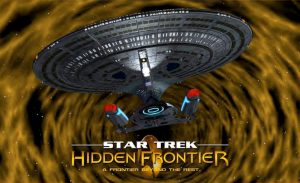 DAVE AND JONATHAN: What first made you want to create a Star Trek fan film? Were you trying to break into Hollywood?
DAVE AND JONATHAN: What first made you want to create a Star Trek fan film? Were you trying to break into Hollywood?
ROB: Hidden Frontier was, first and foremost, a fan effort to continue the Trek series set in the Next Generation universe. It turned out to be helpful for many people involved to further their careers in Hollywood, but that was never my main reason for doing it. It sounded good, and it allowed the show to recruit Hollywood talent and gave everyone a sense that anything could happen if we kept going with it.
D&J: Why set your series in the 24th century right after the Dominion War and not some other era of Trek?
ROB: Deep Space Nine had just wrapped up, and it provided a lot of inspiration for those of us who wanted to see something similar continue. [Voyager was off in the Delta Quadrant.] Also, the somewhat lighter side of sci-fi, Galaxy Quest (1999), provided some bits here and there… including our first choice of theme song. Back then, of course, there were no composers or software to readily produce original material!
D&J: According to IMDb, you only appeared in front of the camera in one episode out of 50 (or 70 if you count the spin-off series and audio episodes). Usually in Star Trek fan films, the creator/executive producer is also the star… or at least a lead. James Cawley played Kirk in New Voyages. Jimm Johnson played Captain Garrovick in Starship Exeter. John Broughton plays Captain Carter in Starship Farragut. Nick Cook plays Captain Hunter in Intrepid. And of course, Alec Peters is playing Captain Garth in Axanar. And the list goes on. You, Rob, are that rare exception. You chose to lead from behind (behind the camera, that is). What made you decide to remain off-screen?

ROB: Being an introvert, I have no aspirations to act, be in front of the camera, or wow people with charisma. That just was never my thing, and I think if anything, it helped HF be a very welcoming environment for people. We had our share of extroverts to be sure, and usually they did most of the directing, acting, and marketing for the show. I just made sure everything was cohesive and a unified front, and that seemed to work pretty well for the ten years or so we made our fan films. However they did talk me into a few cameo roles here and there. I appeared in the first episode of Hidden Frontier because we simply didn’t have enough bodies to play the parts. I reprised the role for the final episode of Odyssey, being a stand in on Cliff Gardner’s ship, the USS Antietam. My largest role was actually an on-set change to replace a regular actor that didn’t show and left the series (something that happened far too often, but without pay it is somewhat inevitable in fan films). At any rate, I actually had lines… much to my horror! I believe that was in Season 3’s “Fire in the Heart.”
D&J: So let’s talk about the actors. Hidden Frontier was one of the first series to cast real actors alongside the novice fans who had little or no formal training. When did you first decide to use real actors, and how did you find them?
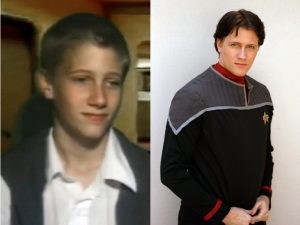
ROB: We actually started using actors when I was still in film school, when we casted Beau Williams for Artim in the Angeles series in 1999 before HF even started. It was awesome to have him grow up on the show from age 13 to 24! As for how we found interested actors, we started advertising in “Backstage West,” a magazine for posting casting notices. As the Internet matured over the run of the show, we switched to nowcasting.com.
D&J: How many actors did you usually audition before making your choice for a role?
ROB: Typically we’d have 20-30 in, but sometimes it varied a lot depending on the size of the role and how clear an idea we had what we were looking for.
D&J: And you never paid any of them?
ROB: No, we never were able to pay any actors, and later when the show became a SAG signatory, things got more complicated, but there still was no compensation for anyone.
D&J: Did the real actors ever help the non-actors do a better job?
RON: Always. People were always happy to run lines while waiting for scenes, and the actors would often end up directing episodes.
D&J: How many of your actors were trained professionals and how many were just fan novices?
ROB: I could not even estimate, but everyone became a real professional in my book by the end. All told, we definitely had a total in the hundreds of people. It was very easy at the time to put out casting notices and bring in lots of small parts that made the shows’ universe feel very big, something DS9 and some of the other Trek shows did a lot. As long as the overall storyline progressed, it didn’t matter if you were on the Enterprise, the station, or some random starship. As Khan (the original from Star Trek II: The Wrath Of Khan) would say, it’s “one big happy fleet!”
D&J: How would you describe the atmosphere on the set?
ROB: It would typically alternate from “party fun time” to serious “get it done” time. Just when things got serious, something hilarious would happen, and everybody would be having fun again.
We always planned for pretty long lunch breaks, and it really felt like we had a starship family right there. The cast and crew got together every other week or so (or sometimes for the whole weekend or two weekends in a row!). People came from all over the world to participate, and even though some of those shoots were very hectic and whirlwind, they were very fun.
Killing off characters was always so deliciously fun, yet sad because we would be saying farewell to someone. That’s why sometimes people came back to play multiple roles. Throw a wig on, and there’s someone new!
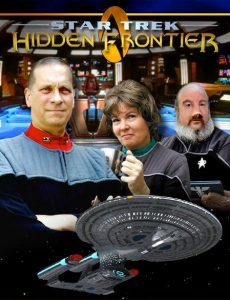 D&J: Do you feel that the Hidden Frontier team members improved as time went on?
D&J: Do you feel that the Hidden Frontier team members improved as time went on?
ROB: All of the actors and crew grew immensely over the ten years. John Whiting stands out as someone who is a self-professed amateur and learned make-up to have a better Tellarite nose than the miss piggy one we started him out on. And his character evolved to be a real fan favorite. He even got his own audio show after HF ended!
Lots of members from the USS Angeles helped over the years, from Dave Mason to Jennifer Cole and Janice Willcocks who all ended up reprising their Angeles roles for the final episode of Odyssey. We definitely couldn’t have done it without the support of the Angeles over the years.
D&J: Some fan film series have studios and sound stages. You had a house in Pasadena, CA. Can you describe your “facility”?
ROB: We were fortunate enough to have a five-bedroom house to film in with a decent yard that made for lots of filming possibilities. The largest room was used for green screen, and another two rooms were used for makeup, costumes, and an editing/control room respectively. We used the yard, and definitely made use of the short drive up to the Angeles National Forest on many occasions.
D&J: What went into making an episode? How long did it take to go from concept to script to footage to final edited production?
ROB: A lot of time! Actually, we got production down to a science with all the backgrounds prepped ahead of time, including animations. We were filming and keying the green screen out live so the actors could see what they were doing on a screen just like the weatherman. This really sped up production and allowed us to do up to nine episodes a year in some seasons. This limited our screen resolution and quality, but we were more like a soap opera production where they film a lot really fast… compared with most fan films that are more akin to feature motion picture production where they spend maybe a year or more filming one episode. At some point, I decided story would be the most important thing and that we would sacrifice some production value to present a grand story that covered many episodes.
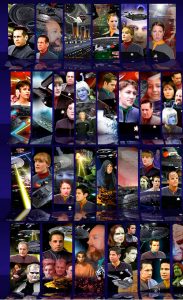
D&J: How do you feel that Hidden Frontier broke new ground in fan filmmaking?
ROB: I think we were one of the first to release online and the first to break 70 episodes. I think some audio shows may have broken that record, but it might still hold for shows of similar scope. We began years before YouTube and QuickTime became a popular way to put video on the Internet in a very compressed form. Building an audience took time. In the first season or two, our viewership was probably pretty small.
Having a gay character was a first for fan films, and for Trek in general. But we did some other social issues too, some of which Trek had done previously, such as euthanasia. And we did a 9/11 conspiracy episode, but it’s the gay stuff we’re usually remembered for.
D&J: What have fans said about the series?
ROB: Some have said – maybe correctly – that at times, HF was a little too CW network-style with the heavy relationship drama. But taken in a broader scope, I think it hit the notes it needed to. Generally fans have been very positive, but with the advent of YouTube, we certainly got our share of criticism, usually about the gay characters, but some of the criticism was valid when we had an episode that fell flat here or there. Or we would also get criticism about the production quality, which was lower than the newer fan films because we were using a green screen right through to the end of the series. Hidden Frontier was always produced on a shoestring budget… sometimes next to nothing once it was going and the cast and crew were helping with costumes, food, and whatnot. It had to excel in other ways, such as writing and story.
D&J: What do you feel has made Hidden Frontier successful?
ROB: Hidden Frontier continued many of the story lines from DS9 and Voyager that a lot of fans grew up with. It wasn’t a reboot or a totally different time period. For me, there’s always something comforting about seeing those uniforms or those starships I grew up with. That made it like a warm blanket from Star Trek’s golden era, which I think of as the 1990s. The next generation may be fans of the new movies or whatever is next, but this was the era of my generation. I think playing in that sandbox connected with that audience.
I also think producing episodes regularly helped. TV shows that are formatted this way seem to be doing the best today, at least in the now seemingly-merged sci-fi/comic book genre.
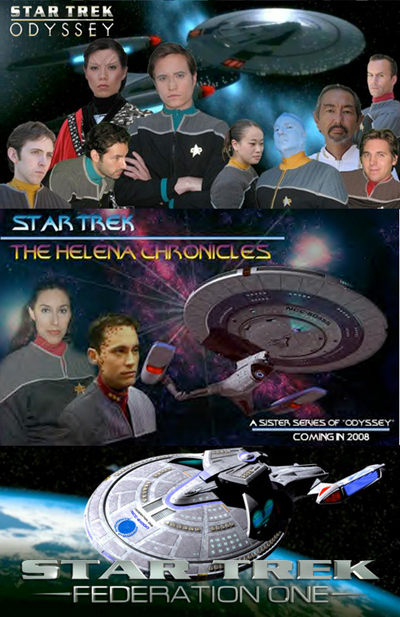
D&J: In 2007, you wrapped up Hidden Frontier and started two separate spinoff series. The following year you added even more spinoffs. Why not just continue with Hidden Frontier? Why end one series and start two others and then others after that?
ROB: We wanted to have the same number of seasons as the Trek shows had to date, which was seven. But more importantly, we told the story we wanted to tell and decided it was time to pass the torch onto a new generation. So Odyssey followed a commander who had started in Hidden Frontier as an ensign, for example. There was a real passage of time and growth among the characters. And it was time to let some new faces shine.
D&J: And then in 2010, all production abruptly halted. What the heck happened?
ROB: We had started an original series, Frontier Guard, in 2009 that proved to be very expensive and time consuming. Additionally, many of us, including me, were starting to get burned out with, at one point, three filmed shows going at the same time! We handed off the audio shows to some very competent fans that have kept some of them going, and we wrapped up the story lines we had started. Real life issues also intervened to hasten the shows’ closure.
D&J: What are your favorite moments from everything you’ve produced?
ROB: Too many to count, but the final wedding and closure of the first Hidden Frontier series was very satisfying. Building everything for seven years and seeing the characters go through the final moments of sadness and happiness is a very special thing. It was the same for the end of the Odyssey spinoff. My favorite moments also included our “big” episodes, such as the premiere of Odyssey, or crossovers with Star Trek: Intrepid in the movie “Operation Beta Shield” and the Federation One mini-series, which gave us a chance to really try different things within the Star Trek universe.
D&J: Which episode(s) would you recommend that someone watch first to get a good introduction to the series and make them want to watch more?
ROB: Season 3 or 4 onward of Hidden Frontier are pretty solid and are a good place to start… or the premiere of Odyssey and Helena Chronicles are pretty accessible for new viewers. If you are really adventurous, then just start with HF or the Angeles series from the beginning. The payoff at the end is pretty cool. If you can only watch one, I’d go for one of the big crossover episodes, either “Vigil,” “Operation Beta Shield,” or one of the final episodes of HF or Odyssey.
Want to take Rob Caves up on his offer? You can find the entire run of all the various Hidden Frontier series on their website.
Here is a direct link to just the seven seasons of Hidden Frontier.
Ratings vary by episode, but in general:
Seasons 1 and 2 – DECENT EFFORT  Season 3 – PRETTY GOOD
Season 3 – PRETTY GOOD![]() Seasons 4 thru 7 –HIGHLY RECOMMENDED
Seasons 4 thru 7 –HIGHLY RECOMMENDED![]()

